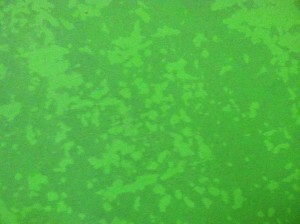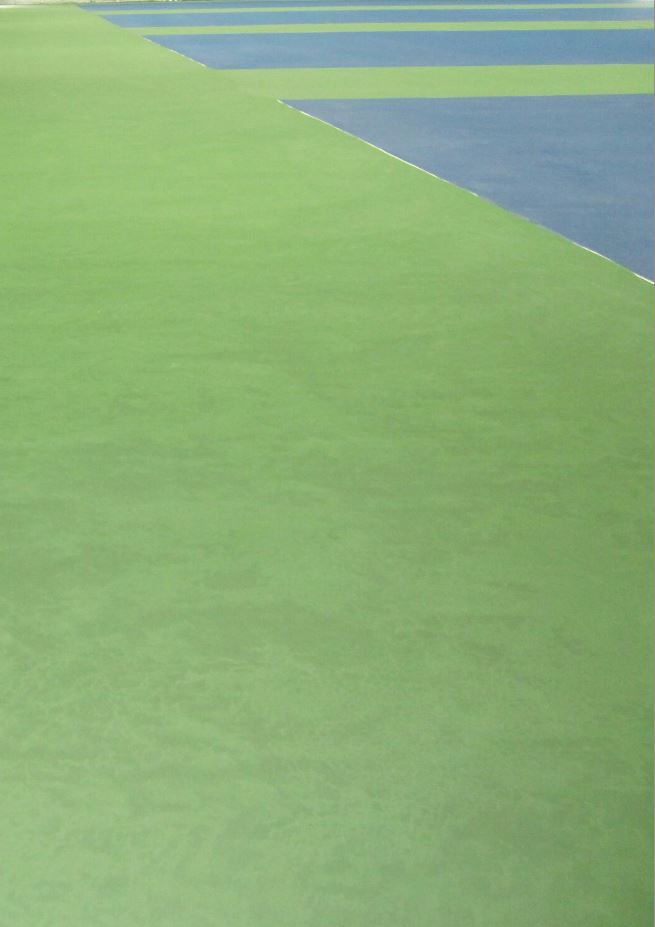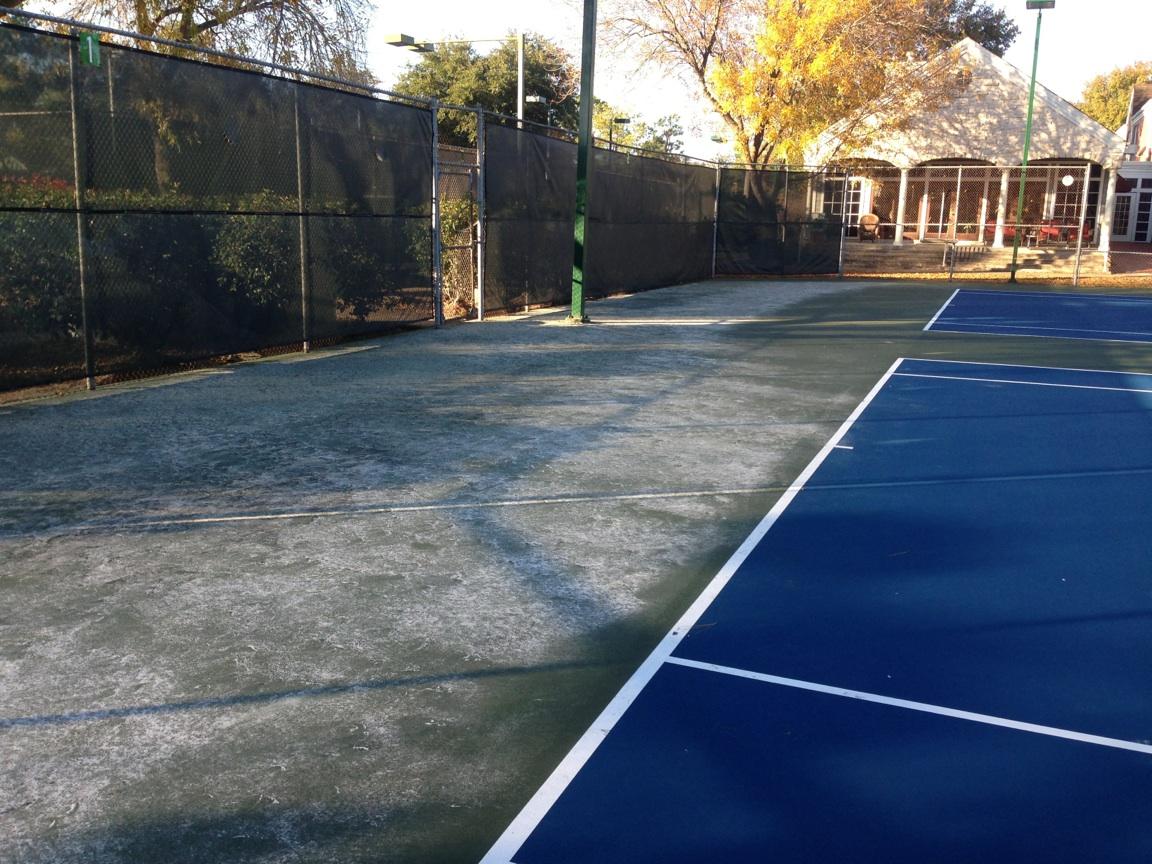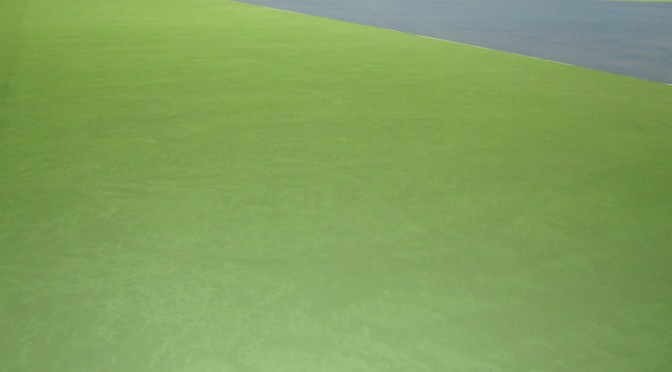Resurfacing indoor tennis and recreational courts can have a few challenges not common to outdoor tennis court resurfacing. Indoor tennis courts do not have to contend with outdoor enemies like UV rays and harsh weather, but some indoor conditions can wreak havoc, even for the experienced tennis court surfacing contractor.
This article is relevant to all kinds of indoor acrylic courts, including by not limited to:
- Pickleball Courts
- Tennis Courts
- Basketball Courts
- Athletic and Recreational areas
Indoor Tennis Court Resurfacing | Drying Problems
Acrylic tennis court surfaces are water-based and dry by evaporation. Water is the vehicle that allows the heavy coating solids to be squeegee applied. Once the coating is applied, the water begins to evaporate. If there is not adequate ventilation in the facility, the water can be trapped in the airspace above the courts and slow down the drying of the surfaces. This can cause a “marbled” look on the coating, resulting in light and dark or patchy areas.

Poor ventilation and cooler outside temperatures can also create problems by causing condensation to “rain” down onto the tennis court surfaces. If the inside temperatures are warmer and the ceiling is cool from colder outside temperatures, the moisture can drip onto the partially cured surface, creating blemishes. To prevent both of these issues, make sure to turn on heating or air conditioning systems to draw humidity out of the air. Open any available vents, doors, and windows to allow an escape route for moisture. Large industrial fans can also be rented and help to circulate the air, as well as push moisture out when placed at exterior doors.

If the facility doesn’t have a good way to expel the moist, humid air, you may need to bring in industrial dehumidifiers. Until the high level of humidity is allowed to escape, the coatings will not be able to dry and cure. They will retain the marbled or uneven drying pattern, and be susceptible to damage and early wear. Plus, when the coatings are like this, it will be very difficult to get tape to stick to the surface for painting the playing lines.
Loose Sand On Indoor Courts | Drying & Curing
It is also common to see loose silica sand on an indoor athletic facility, and sometimes on outdoor courts. Court coatings are fortified with silica sand in order to provide a non-slip surface and ideal ball trajectory for speed of play. The latex binders in acrylic coatings need to dry completely before they can cure. Once the full cure is complete, the coatings can coalesce or fully cure. When the full cure happens, the components (sand in this case) of the coating are full bound and locked in to the coating film. In some cases, this can also have the same affect on pigments. If tennis balls become a bit colored from the surface, it is also a drying/curing issue.
The large amount of evaporating water, from the coatings, can take a while to escape from inside the building. This depends on the ventilation, and more importantly, the exhaust system of the facility. When the indoor humidity level is high, it slows down the cure of the coatings. The silica sand can be rolled out of the coatings and or can migrate out if very humid. There is no need to worry about this, as it will slow down and stop as the full cure is reached.
The quicker you can get the interior humidity level lowered, the sooner the sand roll-out will cease. Here are a few things that can help:
- Rent big agricultural fans and point them outside, by an open doorway to exhaust interior humid air.
- Turn up the heater and run all fans to keep air moving, with the main focus on exhausting the moist air at the same time.
- Air conditioning takes moisture out of the air. Just keep a balance of using AC and heat, since heat helps the curing process more than cool conditions
- Industrial dehumidifiers can also be used to bring inside humidity levels down. Check with local equipment rental stores to find ones for rent.
- Also ensure that the slab/ground temperature and air temperature is well above 50 degrees F. Warmer is much better, but acrylic binders cannot cure when the temperatures are below 50 degree Fahrenheit / 10 Celsius.

Tennis Court Squeegee Application Issues | Smooth Indoor Court Surfaces
Another common problem with surfacing indoor tennis courts is application of coatings on a very smooth surface. Indoor courts do not benefit from the wind and rains, which actually help to move debris off the surface. Dirt and sand particles, that come out of the surface, become abrasive to color coatings under the scuffing of tennis courts. Long-term, this can create a very smooth surface which makes it difficult for application of color coatings. The application squeegee can wipe the coatings off of a smooth surface, and leave a very thin coating. This can sometimes cause irregular color patches or inconsistent textures on the surface. To prevent this, apply the first coat of Acrylic Resurfacer (properly mixed with sand and water) with a squeegee, but follow directly behind with a soft, horse hair-type broom or brush. This puts a fine grooved text in the coating. Once the first coat of Resurfacer is dry, squeegee apply another coat of resurfacer, going the cross-direction. This allows the second coat of resurfacer to “grab” onto the groove finish and deposit a complete textured coat. At this point, the surface is ready to accept the tennis court color coating surface layers.

